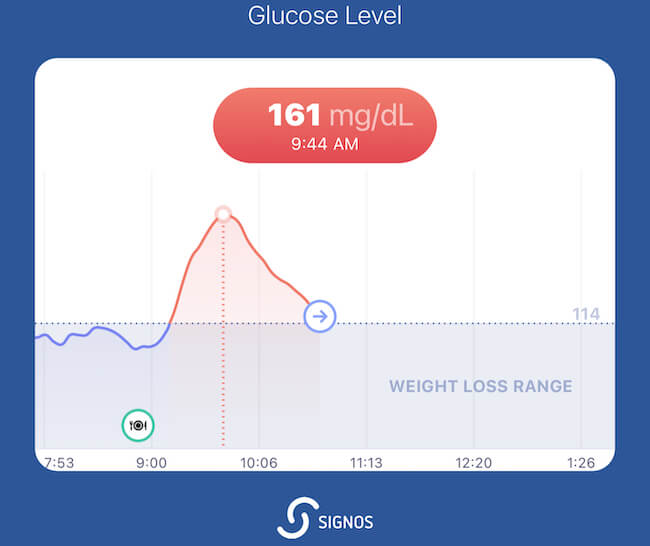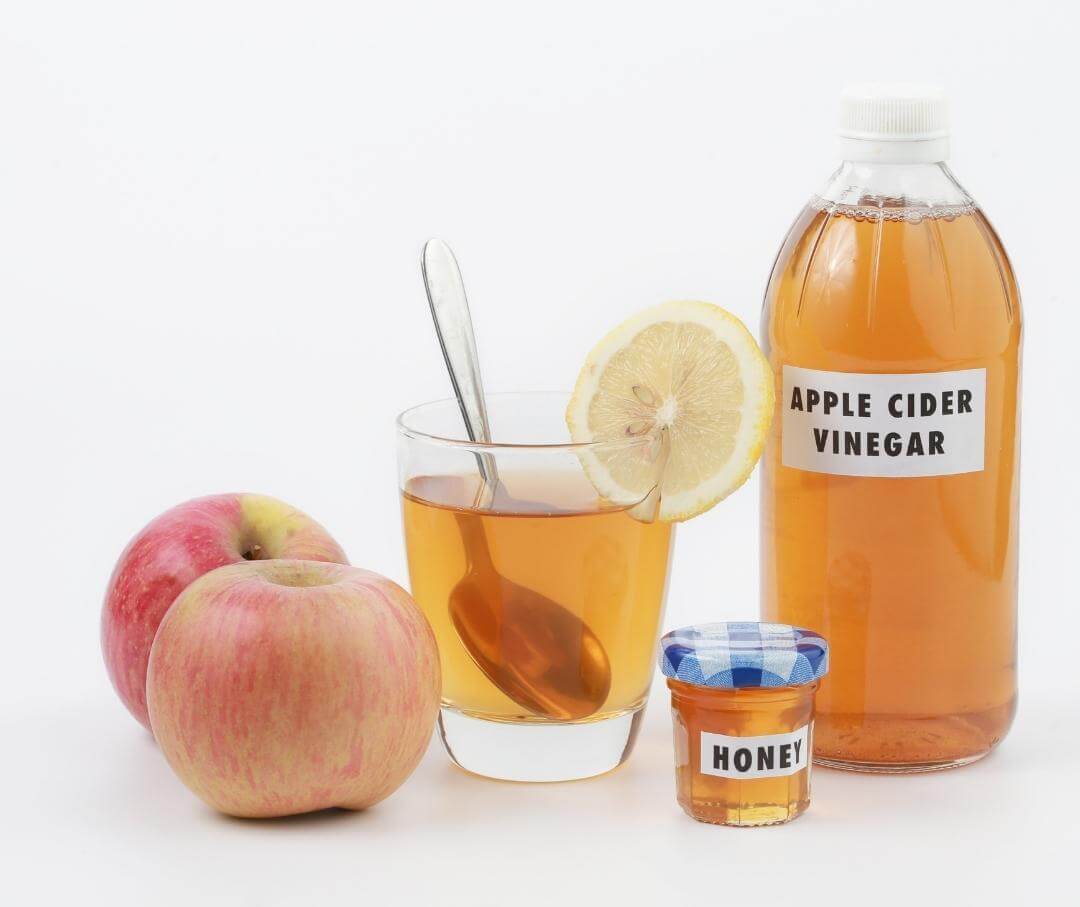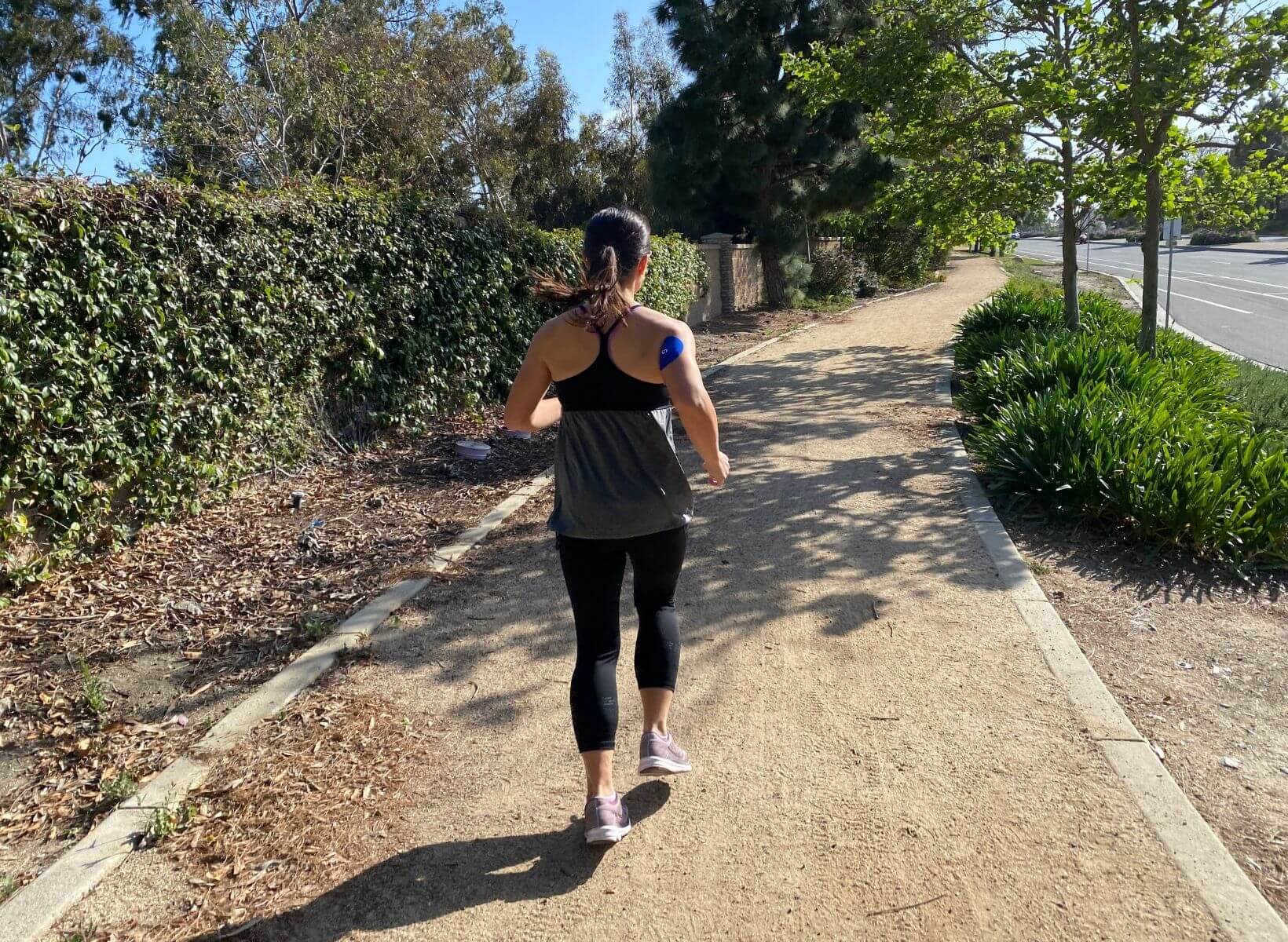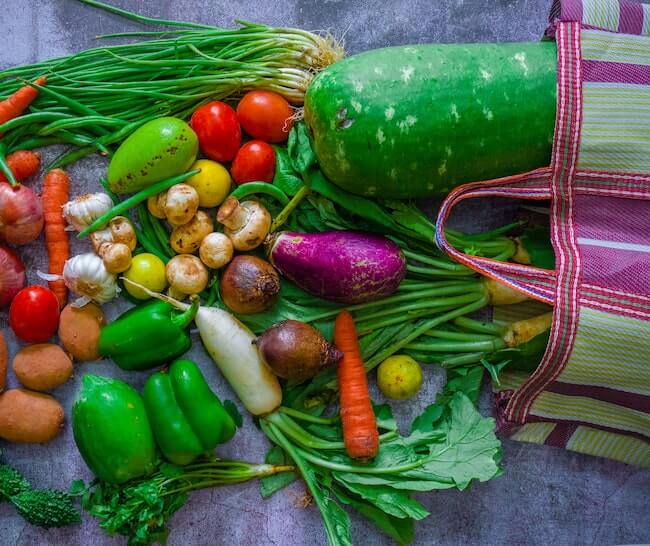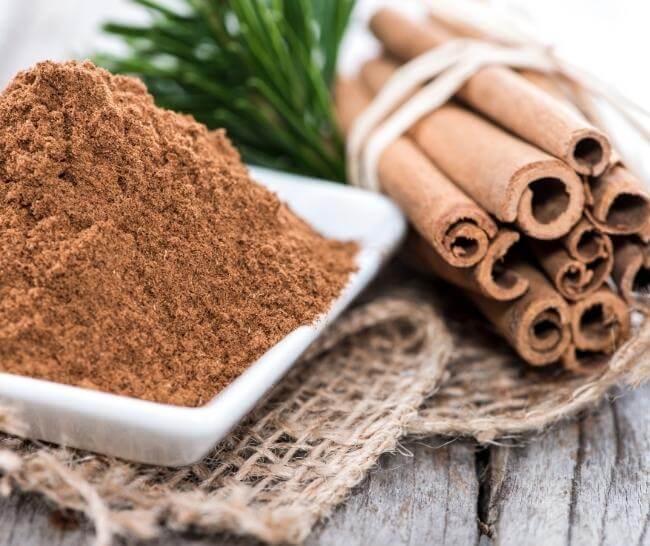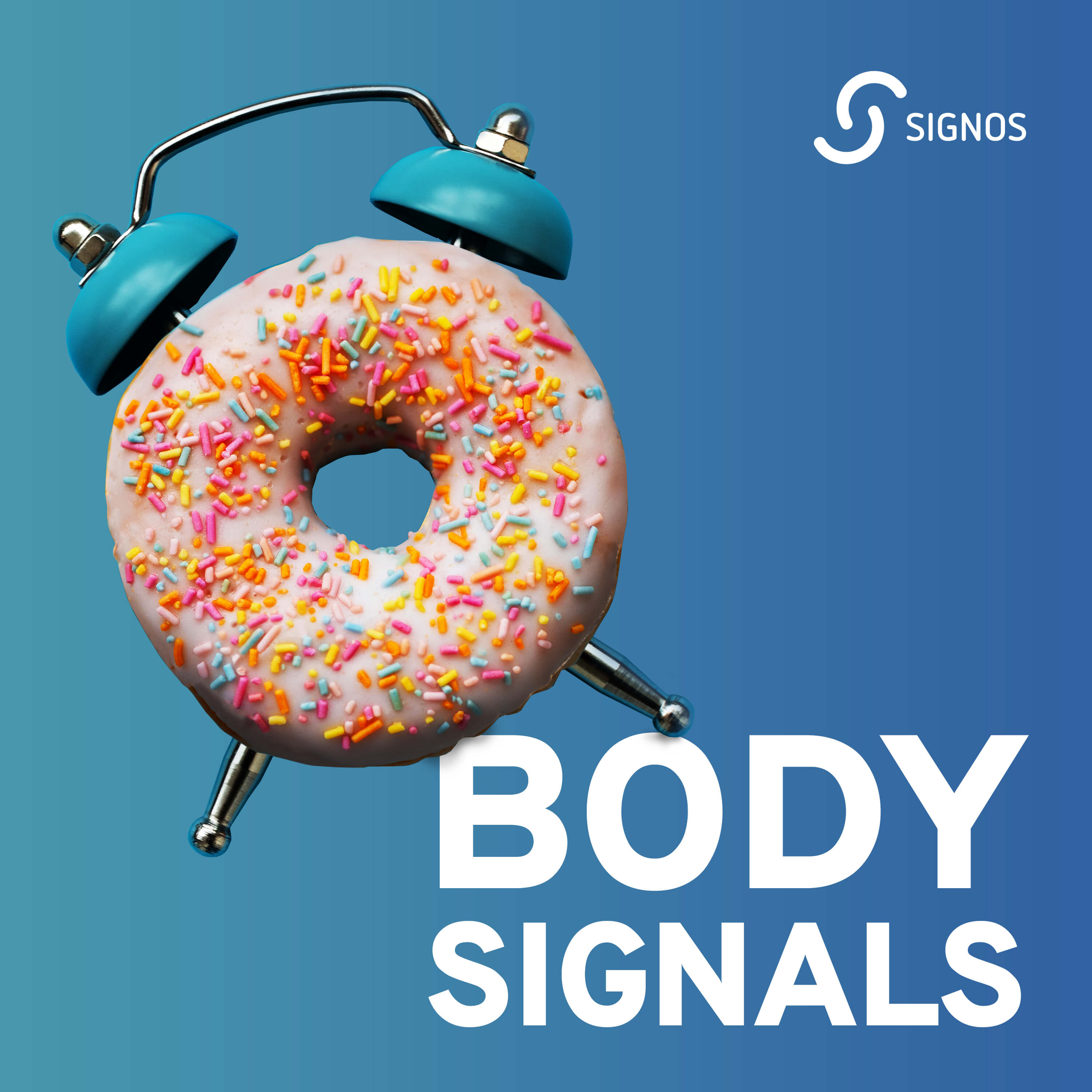A garden salad of crisp greens topped with fresh veggies is a healthy meal choice. Now smother it with your average store-bought thousand island dressing and you’re left with a calorically dense dish, high in saturated fat and sodium, and spiked with sugar. This is a dramatic example of how the condiments you choose can have a major impact on the nutritional value of your food.
Food condiments are used to add flavor and pizzazz to food. Natural and simple flavor enhancers like lemon zest, pepper, and spices, can be healthy choices, as they don’t contain any of the dietary components that are associated with poor health outcomes. Added salt, sugar, syrups, glazes, and many sauces, on the other hand, can sabotage a healthy food choice.
There’s one condiment that makes a splash in nutrition circles. This age-old flavor-enhancer may improve certain foods by dampening their propensity to cause spikes in sugar and insulin. Chemists refer to it as diluted acetic acid. The rest of us call it vinegar.
What Is Vinegar?
Vinegar is a product of fermentation where alcohol is combined with oxygen by harmless bacteria that occur naturally to produce a solution that is typically 5-8% acetic acid. A tablespoon of vinegar is 96% water, has less than three calories, and has zero fat and protein<sup>1</sup>.
Acetic acid is a small molecule, consisting of only two carbon atoms. It’s absorbed by the intestinal tract, easily metabolized by a variety of cells, and incorporated into innumerable structural proteins<sup>2</sup>. When it’s combined with the Vitamin B5-derived coenzyme-A, it plays a key role in many biochemical pathways involved in energy metabolism<sup>3</sup>.
Vinegar and Health
The idea of using vinegar as a medicinal substance is not new. The ancient Greek Hippocrates, considered by some the father of medicine, recommended a mixture of honey and vinegar called “oxymel” for the treatment of chronic cough. In the days of George Washington, vinegar was considered a panacea effective for a range of ailments from stomach aches to poison ivy<sup>4, 5</sup>.
Today, red wine vinegar, often combined with olive oil, is a staple of the Mediterranean diet<sup>6</sup>, which has been associated with a lower risk of death<sup>7</sup> from heart disease and cancer. In the United States, apple cider vinegar, in particular, is often touted for its health benefits. These claims have only recently been reviewed systematically. Though some of the newer studies have few participants, their results are encouraging.
<p class="pro-tip">Learn more about the Mediterranean diet and blood sugar</p>
In this article, I will focus on one health aspect in particular: the ability of apple cider vinegar to blunt the body’s glycemic response to food and the dampening of insulin secretion. We will look at some of the published literature and discuss a neat little experiment carried out by employees of Signos that we call the Apple Cider Vinegar Challenge.
Beyond the Glycemic Index
After we eat a meal, our blood sugar levels rise and, in response, our pancreas secretes insulin. How much blood sugar rises depends on what we eat. Every food is rated by a tool called the glycemic index<sup>8</sup>. Simply stated, the glycemic index is the expected elevation in blood sugar for a particular food (compared to plain table sugar, which is assigned the maximum index of 100).
<p class="pro-tip">Read more about glycemic index and glycemic load.</p>
But portion size matters. The more food you eat, the higher your blood sugar will rise. The measure that considers both the glycemic index of a food and the serving size is called glycemic load. Diets with high glycemic loads are associated with poorer health outcomes, including a higher risk of obesity, diabetes, and heart disease<sup>9</sup>.
<p class="pro-tip">Read more about the low glycemic diet.</p>
The problem with this paradigm is that we almost never eat a single food in isolation. A meal typically consists of several different foods. And some foods can blunt the spikes in blood sugar that usually come after a high-carb meal. Vinegar, in particular, seems to be such a food.
Apple Cider Vinegar and Blood Sugar
Can vinegar reduce the sugar spike following starchy meals? The answer at this point is maybe. Studies involving human subjects are encouraging but limited by their small size.
An Italian study measured blood glucose in five healthy volunteers fed 50 grams of white bread chased by lettuce dressed with either olive oil alone, olive oil plus vinegar, or olive oil with neutralized vinegar. When taking the vinegar salad, the subjects had a 30% lower post-meal blood glucose<sup>10</sup> compared to no vinegar. Similar results were obtained in a Japanese study<sup>11</sup> of 58 volunteers where the carbohydrate meal consisted of white rice.
The beneficial glycemic effects of vinegar may benefit healthy subjects and individuals with diabetes. Blood samples were obtained from patients with insulin-resistant diabetes 30 and 60 minutes after a test meal consisting of 87 grams of carbohydrates. They were also given either a drink with about one tablespoon of apple cider vinegar or a placebo drink. Taking apple cider vinegar resulted in improved insulin sensitivity<sup>12</sup>. Again, the study’s conclusions are limited by its size—a total of just 29 subjects participated.
How does vinegar produce its glucose-busting effects? For starters, it acts in the gastrointestinal tract by delaying food transfer<sup>13</sup> from the stomach to the small intestine, thus slowing the speed of absorption of simple sugars. It also reduces the activity of certain cell enzymes<sup>14</sup> that cleave more complex carbohydrates into free sugar.
Finally, vinegar seems to stimulate the uptake of glucose into muscle tissue to be stored as glycogen<sup>15</sup>, according to a small study conducted on diabetic participants.
If vinegar helps maintain lower blood sugar levels after a carbohydrate meal, can it also reduce levels of insulin?
{{mid-cta}}
Apple Cider Vinegar and Insulin Resistance
Persistently elevated blood insulin levels have been associated with poor health outcomes including type 2 diabetes, obesity, heart disease, and even cancer<sup>16</sup>. There is growing evidence that controlling insulin levels along with blood sugar leads to better health. The question is, can vinegar help normalize insulin secretion?
It appears so, but larger studies are needed. A Swedish group found that 12 individuals had lower blood sugar and insulin levels<sup>17</sup> after consuming vinegar and eating white bread. The researchers identified a dose-response relationship with respect to vinegar ingestion. The lower the amount of vinegar taken, the higher the spikes in insulin and blood glucose.
The Apple Cider Vinegar Challenge
One way to numb the sting of disappointment from the scarcity of data on the effects of vinegar on blood sugar is to check your own response in the Apple Cider Vinegar Challenge. A group of employees at Signos did just that under the direction of Dr. William Dixon.
<p class="pro-tip">Listen to this podcast about the Signos apple cider vinegar experiment.</p>
Here’s how the apple cider vinegar challenge went down. On consecutive days, each participant ate the same portion of a high-glycemic carb first by itself (fasted, or when glucose levels were stable), the next day they ate the same amount of the high-GI carb along with two tablespoons of apple cider vinegar (ACV). Glucose responses were measured using a Continuous Glucose Monitor (CGM) and data tracked and contextualized in the Signos app.
If you’re not familiar with CGMs, they’re a small monitor you can place on the skin on the back of the upper arm or your stomach. By way of a hair-thin probe, it continuously monitors interstitial glucose levels (the glucose in the fluid between your cells), which is a good surrogate for blood glucose. Best of all, it is painless, and syncing the data from a CGM to an app like Signos means you can check your trends as often as you like. The amount of data it retrieves is far more than you can get from poking your finger a few times a day.
Below are the apple cider vinegar challenge results for two Signos employees.
Reed’s Apple Cider Vinegar Results
Reeds’s test food was an English muffin with butter. On day 1 he ate it without vinegar and as you can see, his glucose reached a max of 161. The next day, after priming himself with apple cider vinegar, eating the muffin raised his blood sugar to 132—an 18% improvement.
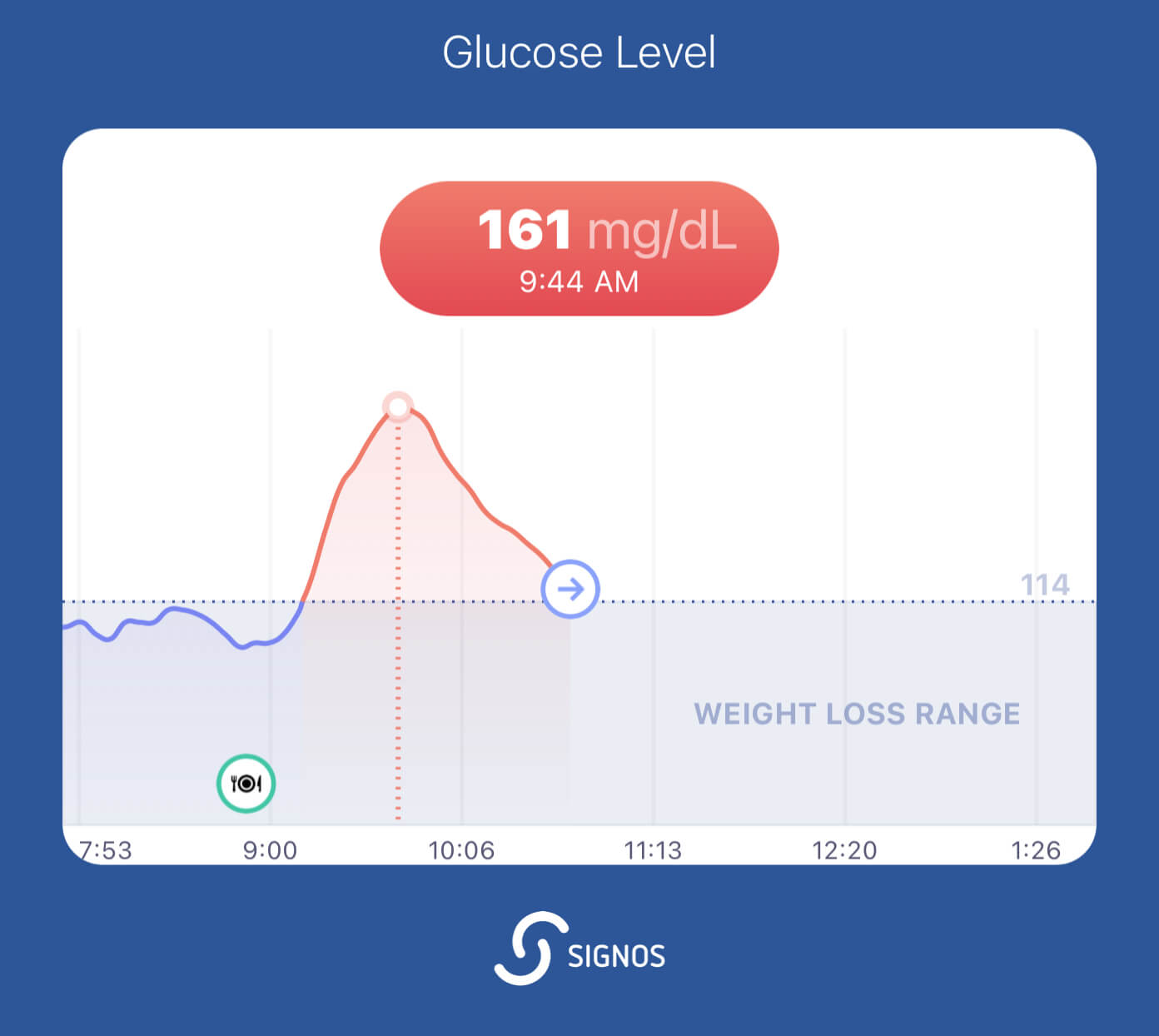
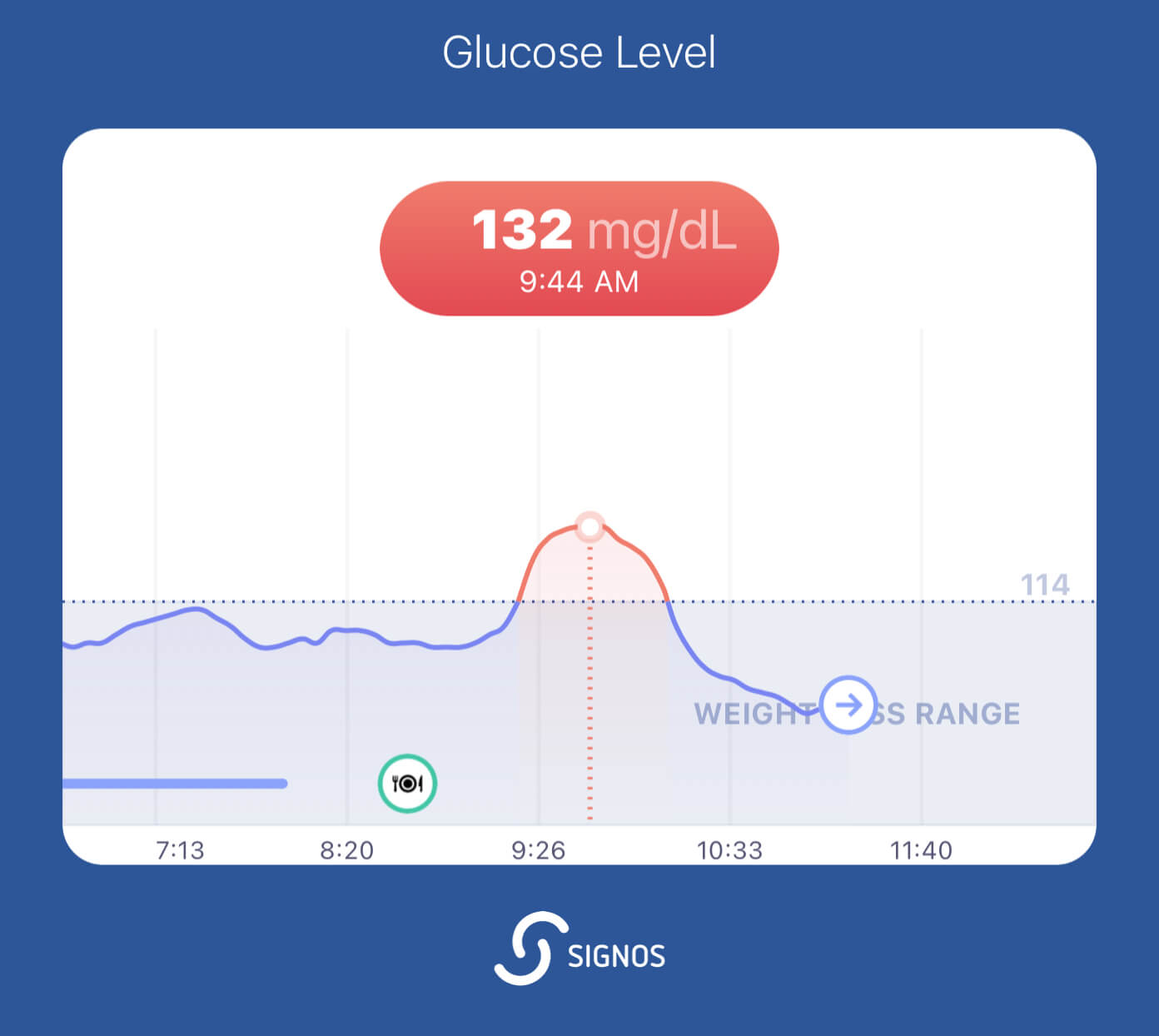
William’s Apple Cider Vinegar Results
The results were even more dramatic for William, who decided to try his luck with ciabatta bread. On day 1 his sugar spiked to 167. But the next day, with 2 tablespoons of vinegar, it only reached 103.
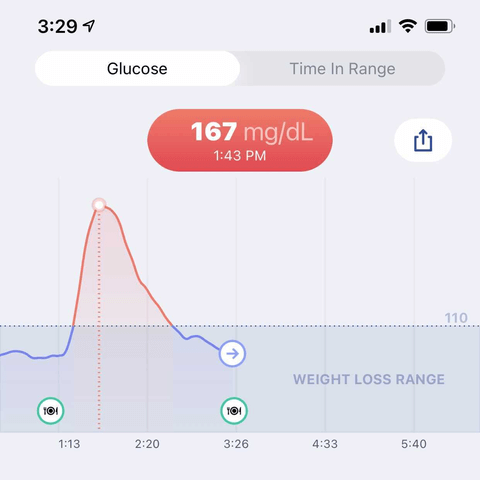

About the Results
Not all the participants reported improvements with vinegar supplementation. In part, this might have been because they did not all choose the same test food. It also reflects the fact that, as individuals, we have different susceptibilities to glucose volatility.
Tools such as glycemic index and glycemic load are helpful rules of thumb in guiding our food choices, but they’re not entirely adequate since we rarely eat a single food item by itself. And, as we’ve seen, combinations of foods sometimes produce surprising fluctuations in our glycemic response to a meal.
Continuous glucose monitors are likely to play an ever-larger role in the management of diabetes, pre-diabetes, and weight management. They may also become a popular tool among healthy individuals who simply want to learn how their bodies react to certain foods, stress, exercise, and other situations.
Is Taking Apple Cider Vinegar Safe?
Vinegar has been safely used as a food condiment for thousands of years. It appears to be quite safe at the concentration of one or two tablespoons diluted in a glass of water. Undiluted vinegar, taken repeatedly over a prolonged period of time can cause irritation of the intestinal lining, and has even been reported in one case as a cause of esophageal erosions<sup>18</sup>. Avoid drinking undiluted vinegar, and, as always, check with your doctor before taking any supplement for medicinal purposes.
Next time you have a salad, consider preparing it the Mediterranean way, with a few splashes of vinegar and some olive oil. Consider adding oil and vinegar to mashed potatoes instead of butter, to baked beans, crispy cucumbers, and fresh vegetables.
If you have access to a continuous glucose monitor, take the apple cider vinegar challenge. Pick a starchy item as your test food and be sure to dilute one or two tablespoons of apple cider vinegar in a glass of water. If you do not have a continuous glucose monitor and are struggling with prediabetes or to maintain a healthy weight, consider asking your doctor if one of these devices is right for you. The results it will provide may surprise you.
<p class="pro-tip">Related reading: Does apple cider vinegar help you lose weight?</p>
- Item 1
- Item 2
- item 3
Topics discussed in this article:
References
- https://www.nutritionvalue.org/Vinegar%2C_distilled_nutritional_value.html
- https://www.sciencedirect.com/science/article/pii/B9780123864543002165
- https://pubmed.ncbi.nlm.nih.gov/26039447/
- http://classics.mit.edu/Hippocrates/acutedis.mb.txt
- https://www.ncbi.nlm.nih.gov/pmc/articles/PMC1785201/#R1
- https://pubmed.ncbi.nlm.nih.gov/15788119/
- https://www.ncbi.nlm.nih.gov/pmc/articles/PMC2533524/
- https://pubmed.ncbi.nlm.nih.gov/6259925/
- https://pubmed.ncbi.nlm.nih.gov/33626252/
- https://pubmed.ncbi.nlm.nih.gov/7796781/
- https://pubmed.ncbi.nlm.nih.gov/12792658/
- https://diabetesjournals.org/care/article/27/1/281/26582/Vinegar-Improves-Insulin-Sensitivity-to-a-High
- https://pubmed.ncbi.nlm.nih.gov/9630389/
- https://pubmed.ncbi.nlm.nih.gov/10702577/
- https://www.ncbi.nlm.nih.gov/pmc/articles/PMC4438142/
- https://pubmed.ncbi.nlm.nih.gov/33775061/
- https://pubmed.ncbi.nlm.nih.gov/16015276/
- https://www.ncbi.nlm.nih.gov/pmc/articles/PMC7280853/

